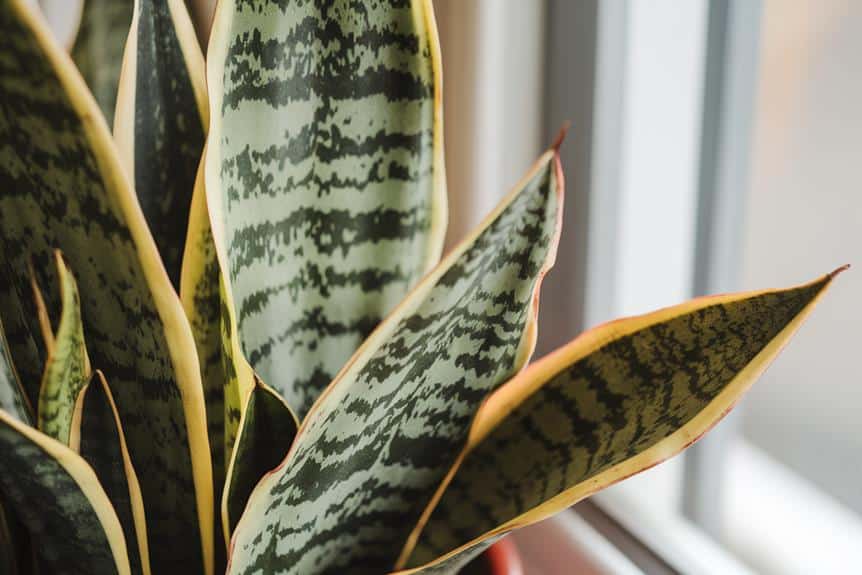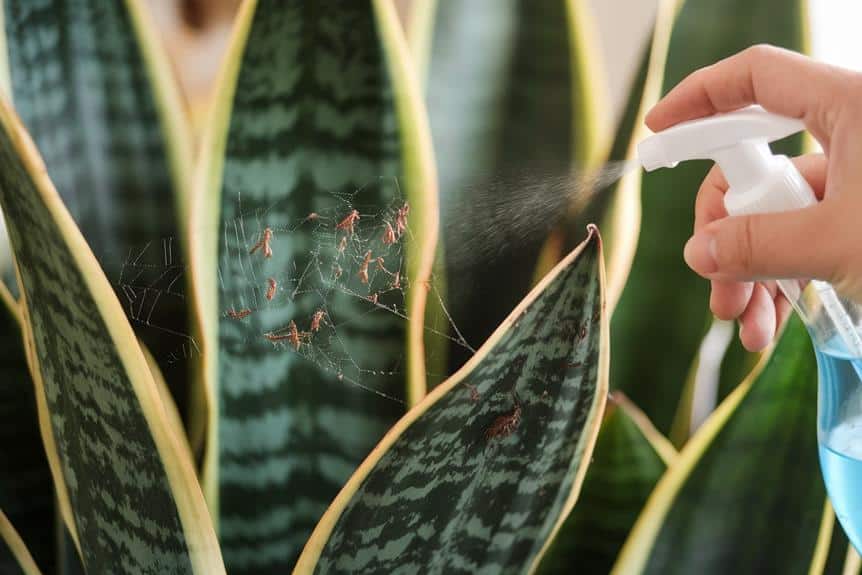Common Snake Plant Problems & How To Fix Them
Are your snake plant’s leaves turning a sickly yellow? Is root rot slowly killing your beloved houseplant? Or perhaps pesky pests have decided to crash the party? Fear not, plant parent! We’ve got the ultimate guide to solving the most common snake plant problems. From overwatering woes to nutrient deficiencies, we’ll equip you with the knowledge to rescue your green companion and help it flourish. Get ready to become the snake plant whisperer your friends envy!
Contents
Yellowing Leaves

Frustration often sets in when you notice your snake plant’s leaves turning yellow. This common issue usually stems from overwatering, which can lead to root rot. To fix this problem, first check the soil moisture. If it’s soggy, allow the plant to dry out completely before watering again. Reduce your watering frequency and guarantee proper drainage in the pot.
Yellowing leaves can also result from nutrient deficiencies, particularly a lack of nitrogen. Address this by fertilizing your snake plant with a balanced, water-soluble fertilizer during the growing season. If only the outer leaves are yellowing, it might be a natural aging process. In this case, simply trim the affected leaves to maintain the plant’s appearance.
Lastly, insufficient light can cause yellowing. Move your snake plant to a brighter location, but avoid direct sunlight, which can scorch the leaves.
Root Rot
Root rot, the silent killer of snake plants, can quickly devastate your beloved houseplant. This problem often stems from overwatering or poor drainage, creating an environment where fungi thrive. You’ll notice signs like mushy, brown roots, wilting leaves, and a foul odor emanating from the soil.
To save your snake plant, act fast. Remove it from its pot and gently wash away the soil from the roots. Trim off any brown, mushy roots with clean, sharp scissors. Treat the remaining roots with a fungicide solution. Repot your plant in fresh, well-draining soil and a clean container with drainage holes. Adjust your watering routine, allowing the soil to dry out between waterings. Remember, snake plants prefer neglect to excess attention. By addressing root rot promptly, you’re giving your plant the best chance to recover and thrive.
Pest Infestations

While snake plants are generally hardy, they’re not immune to pest infestations. Common pests that attack snake plants include spider mites, mealybugs, and fungus gnats. You’ll notice tiny webs, cotton-like clusters, or small flying insects around your plant. To combat these invaders, start by isolating the affected plant to prevent spread. Then, wipe the leaves with a damp cloth to remove visible pests.
For persistent infestations, use neem oil or insecticidal soap, applying it to both sides of the leaves. Guarantee you’re not overwatering, as moist soil attracts pests. Regularly inspect your snake plant for early signs of infestation, paying close attention to leaf undersides and stem joints. By staying vigilant and addressing pest issues promptly, you’ll help your snake plant thrive and continue to purify the air in your space.
Drooping or Wrinkled Leaves

Drooping or wrinkled leaves on your snake plant can be a sign of several underlying issues. The most common causes are overwatering, underwatering, or temperature stress. If you’ve been overzealous with watering, allow the soil to dry out completely before watering again. For underwatered plants, increase watering frequency but guarantee proper drainage. Check that your plant isn’t exposed to drafts or extreme temperatures, as this can cause leaf wrinkling.
Nutrient deficiencies can also lead to drooping leaves. Consider fertilizing with a balanced, water-soluble fertilizer during the growing season. If you notice brown or yellow spots accompanying the drooping, inspect for pests or fungal diseases. Treat accordingly with neem oil or an appropriate fungicide. Remember, a healthy snake plant has firm, upright leaves. By addressing these issues promptly, you’ll help your plant recover and thrive, ensuring it continues to purify the air in your space.
Slow or Stunted Growth
Slow or stunted growth in snake plants can be frustrating for plant owners. If your snake plant isn’t thriving, it’s likely due to insufficient light, improper watering, or nutrient deficiencies. To address this issue, first guarantee your plant receives adequate indirect light. Move it closer to a window if necessary, but avoid direct sunlight.
Next, check your watering habits. Snake plants prefer to dry out between waterings, so only water when the top inch of soil feels dry. Consider fertilizing your plant with a balanced, water-soluble fertilizer during the growing season to provide essential nutrients. If the pot is too small, repot your snake plant into a slightly larger container with well-draining soil. By addressing these factors, you’ll help your snake plant resume healthy growth and serve as a beautiful addition to your space.
